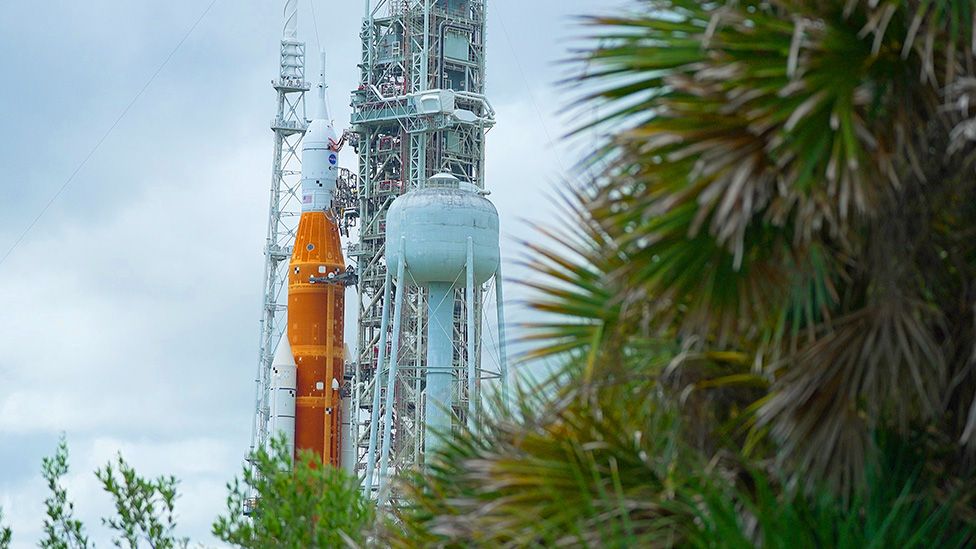Nasa: Artemis Moon rocket to make second launch attempt
The US space office will endeavor by and by before long to send off its most impressive at any point rocket.
Nasa was upset by a blend of specialized and climate hardships when it attempted to get the Artemis I Moon mission off Earth on Monday.
In any case, the mind-set stays positive at Florida's Kennedy Space Center.
"We must appear, we must be prepared and we must see what the day brings," Mike Sarafin, Nasa's Artemis mission director, told journalists.
Saturday's endeavor to despatch the Space Launch System (SLS) rocket has been booked for the beginning of a two-hour window that starts at 14:17 neighborhood time (19:17 BST; 18:17 GMT).
Nasa cancels new Moon rocket send off
A visual mission to show us the Moon
Artemis: To the Moon and then some
The 100m-tall vehicle's goal will be to fling a human-evaluated case toward the Moon, something that hasn't occurred since Project Apollo finished in 1972.
Artemis I is an innovation show, so there will be no team on board on this event, however should everything go to anticipate the mission then Artemis II, expected to fly in 2024, certainly will convey people.
Nasa space traveler Jessica Mier said everybody ought to consequently show some persistence as the SLS moves towards its lady flight, and to not be shocked on the off chance that there is a further delay.
"No doubt, obviously it's baffling for everyone, except it's not unforeseen," she told BBC News.
"It's important for how we get things done at Nasa. The SLS will ultimately have people on it, my companions, my partners. Thus, we really want to ensure this experimental drill works out in a good way."
Realistic of SLS
How we return people once again to the Moon
Monday's offered to fly SLS was at last cleaned on the grounds that regulators couldn't rest assured the four major motors under the rocket's center stage were appropriately ready for flight.
The van period power units are chilled during commencement to - 250C to forestall them being stunned by the unexpected infusion of cryogenic fuels right now of send off. In any case, a sensor was showing that Engine No 3 may be 15-30 degrees shy of where its temperature required to have been.
Charge Muddle from maker Aerojet Rocketdyne is sure however that the sensor was flawed, and assuming it hypes again on Saturday it will probably be disregarded.
"Having investigated the information and the wide range of various markers, Engine No 3 might really have been somewhat colder than the others on Monday," he said.
"We presently comprehend what we really want to go glance at to settle in to go send off."
Media inscription,
Previous space traveler Doug Hurley: "We're expanding on protected, able plans"
On the off chance that the SLS moves away this time, being a breathtaking sight is certain.
"It will be 'transport on steroids'," said Doug Hurley, who was the pilot on the absolute last transport mission in 2011.
The previous space explorer presently works for Northrop Grumman who make the enormous white strong promoters on the sides of the SLS.
"My thought process was the coolest thing about transport dispatches was you saw it lift off and it was well clear of the pinnacle before you heard anything, and afterward it was even somewhat longer before you felt it," he made sense of.
"Push to weight-wise, SLS is very near what transport was. Apollo's Saturn V rocket was radically unique. I never saw it face to face yet it blundered clear of the cushion. For transport, it appeared as though it was clear in a moment, nearly when the promoters were lit. SLS ought to be something very similar," he told BBC News.
Moon course
The principal controlled period of the SLS's climb will endure a little more than eight minutes.
This will put the upper-phase of the rocket, with the Orion case actually connected, into an exceptionally circular circle that would see both of them come crashing back to Earth with no further exertion.
Thus, the upper-stage should raise and circularize the circle before then helping Orion toward the Moon.
Affirmation that the case is all alone, on target and speeding through space at 30,000 km/h (19,000mph) ought to come two hours and five minutes after send off.
The arranged mission length is just shy of 38 days. This would bring about Orion getting back to Earth for a splashdown in the sea off San Diego in California on 11 October.
38 days is significantly longer than the 21 days that case producer Lockheed Martin says is the greatest time space explorers ought to spend in the rocket.
However, Annette Hasbrook, senior counselor on the Orion program at Nasa, said engineers needed to extend the shuttle on this mission to grasp its cutoff points.

Comments
Post a Comment